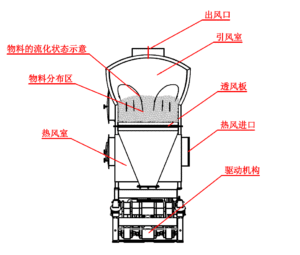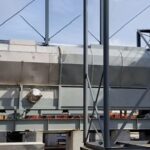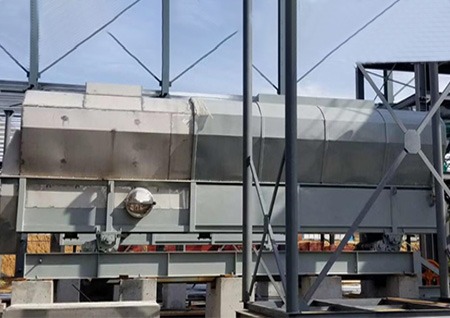LCA
Vibrating fluidized bed dryer for ceramic powder
Description
Reciprocating vibrating fluidized bed dryer uses and features:
Application: Suitable for drying ceramic tile raw material particles in dry powder production projects. Our company designed and produced the EFD20 reciprocating vibrating fluidized bed dryer for a company in Yantai, Shandong. It is used to dry ceramic powder with a particle size distribution of 20-120 mesh, a bulk density of 0.8T, and a moisture content of 12%±2. The maximum production capacity is 22.5T/H . Natural gas is used as the drying energy source. The energy efficiency analysis is as follows:
| project | unit | Consumption | unit price | Operating cost (yuan/hour) | Unit cost (yuan/ton) |
| Power consumption | kW/h | 138/0.8 degrees/H | 0.6 yuan/KW | 66.24 | 3 |
| natural gas | KG | 247m³/H | 3.1 yuan/KG | 512.5 | 34.34 |
| Artificial | ton | 4 people | 200 yuan/person/day | 100 | 4.5 |
| total | 41.84 |
Features: Suitable for drying and drying various materials, low energy consumption, large output and uniform drying.
Technical advantages: The reciprocating vibrating fluidized bed adopts a crank-connecting rod mechanism as the excitation source, which can effectively ensure that the material steps synchronously and first-in-first-out, ensuring that the drying material is dried evenly and uniformly.
Noise reduction and environmental protection: The equipment drive motor adopts variable frequency electrical appliances, the driving mode is variable frequency drive, and air springs are used as shock absorbers to effectively improve the utilization efficiency of the motor and more effectively reduce the vibration generated when the equipment is working.
Variable frequency drive: The equipment drive motor adopts variable frequency drive, which can more effectively improve the utilization efficiency of the motor and finely control the drying time of the material.
Energy saving and consumption reduction: Through the refined control of air volume and air pressure linked by frequency conversion and damper, the material can achieve sufficient heat exchange in the fluidized state, with low waste heat of exhaust gas, thus achieving high efficiency and energy saving;
Automatic control: Realize medium and long-distance centralized control and fully automatic operation through the signal input and output of instruments and meters.
The principle of reciprocating vibrating fluidized bed:
1) The reciprocating fluidized bed adopts a special vibration drive mechanism, which evenly applies lifting and lowering push and pull forces to the bed through the crossbeam, so that the entire bed is subjected to very uniform force.
2) The bed shakes when working, instead of the traditional vibrate. Therefore, the material transportation can be kept synchronous.
3) The material conveying speed is uniform, and with the appropriate air volume, the material reaches a very good fluidized state. The fluidized state driven by shaking promotes a step-by-step and sufficient heat exchange between gas and solid, avoiding heat energy waste.
4) The special driving method drives the bed to shake each time, and the distance the material moves is stable, so the material conveying speed and heating time can be adjusted and controlled, thereby controlling the moisture content of the material after drying, ensuring that the moisture content and temperature of the product after drying are uniform.
5) By changing the vibration frequency, the moving speed of the material can be precisely controlled, so that the residence time of the material can be adjusted arbitrarily over a wide range in a very short bed surface (the throwing intensity is related to the specific gravity of the material). The bed does not need to be very long to achieve sufficient drying time for the material to meet the required moisture requirements.
6) The drying efficiency of the reciprocating fluidized bed is greatly improved, while the vibration frequency can be kept at a low frequency. In addition, the bed body adopts rubber springs to absorb shock, so the destructive force on the bed body welds is quite low, which substantially extends the working life of the equipment.
7) Through reasonable design, the amount of fine powder carried in the exhaust gas can be very low, thus eliminating dust pollution in the working environment to a great extent.

Application areas:
It is widely used in industrial fields such as brick and tile building materials, mining, metallurgy, chemical industry, food, hazardous waste and urban garbage treatment, feed, compound fertilizer, etc.
Technical parameters:
| type | Feeding status | Inlet air temperature | Air outlet temperature | Water evaporation | Equipment power | weight |
| ED05 | Powder/granular material | 200-350 | 60-80 | 0-300 | 5.5 | 3.5 |
| ED10 | Powder/granular material | 200-350 | 60-80 | 300-600 | 7.5 | 4.5 |
| ED20 | Powder/granular material | 200-350 | 60-80 | 600-1200 | 11 | 6 |
| ED30 | Powder/granular material | 200-350 | 60-80 | 1200-1800 | 15 | 7.7 |


